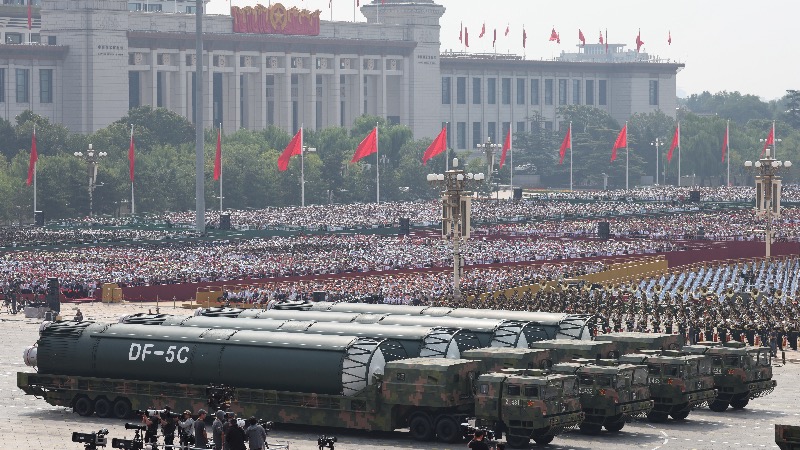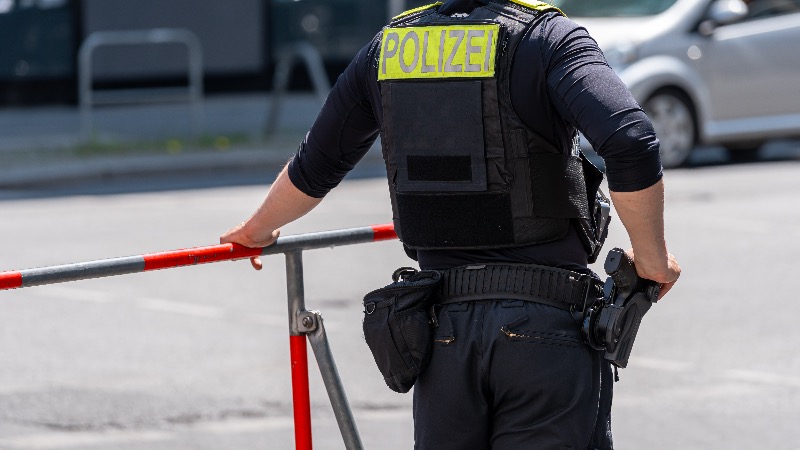 Image Credit: China News Service / Contributor / Getty
Image Credit: China News Service / Contributor / Getty On Sunday President Donald Trump appeared on CBS’s 60 Minutes where he discussed a litany of issues, including China’s atomic ambitions. Beijing expanded their nuclear arsenal by 20 percent over the past year while a suspicious arrest of three Chinese nationals in the nation of Georgia over an alleged uranium purchase may invoke fears of a radiological false flag attack.
During the 60 Minutes interview on Sunday Trump doubled down on his promise to restart U.S. nuclear weapons testing:
President Trump: Well, we have more nuclear weapons than any other country. And I think we should do something about denuclearization. And I did actually discuss that with both President Putin and President Xi. We have enough nuclear weapons to blow up the world 150 times. Russia has a lot of nuclear weapons, and China will have a lot. They have some. They have quite a bit, but—
Norah O’Donnell: So why do we need to test– our nuclear weapons?
President Trump: Well, because you have to see how they work. You know, you do have to— and the reason I’m saying— testing is because Russia announced that they were going to be doing a test. If you notice, North Korea’s testing constantly. Other countries are testing. We’re the only country that doesn’t test, and I want to be— I don’t want to be the only country that doesn’t test.
Norah O’Donnell: Are you saying that after more than 30 years, the United States is going to start detonating nuclear weapons for testing—
President Trump: I’m saying that we’re going to test nuclear weapons like other countries do, yes.
Norah O’Donnell: But the only country that’s testing nuclear weapons is North Korea. China and Russia are not—
President Trump: Well, Russia’s— no, no. Russia’s testing nuclear weapons—
Norah O’Donnell: So my understanding–
President Trump: And China’s testing ’em too. You just don’t know about it.
Norah O’Donnell: That would be certainly very newsworthy. My understanding is what Russia did recently was test essentially the— delivery systems for nuclear weapons, essentially missiles, which we can do that but w— not with nuclear warheads—
President Trump: Russia’s testing, and China’s testing, but they don’t talk about it. You know, we’re a open society. We’re different. We talk about it. We have to talk about it, because otherwise you people are going to report— they don’t have reporters that going to be writing about it. We do.
Following the path of the U.S. and Russia in the mid-20th century, China is now building up its own world-ending nuclear war abilities.
In June the Stockholm International Peace Research Institute detailed on Beijing’s bomb buildup, surging 20 percent in one year:
SIPRI estimates that China now has at least 600 nuclear warheads. China’s nuclear arsenal is growing faster than any other country’s, by about 100 new warheads a year since 2023. By January 2025, China had completed or was close to completing around 350 new ICBM silos in three large desert fields in the north of the country and three mountainous areas in the east. Depending on how it decides to structure its forces, China could potentially have at least as many ICBMs as either Russia or the USA by the turn of the decade. Yet even if China reaches the maximum projected number of 1500 warheads by 2035, that will still amount to only about one third of each of the current Russian and US nuclear stockpiles.
The Bulletin of Atomic Scientists covered China’s rise to a nuclear superpower as well.
The Australian Broadcasting Corporation (ABC) reported how Australia is supplying China with zirconium, a rare earth mineral which Beijing does not have domestic access to. Zirconium is vital for China’s hypersonic missiles and nuclear programs:
Not only did Australian regulators allow Beijing-backed companies to become major shareholders in the two Western Australia mines, the federal government even gave one of them a $160 million soft loan to help it into production.
Australia is supplying these raw materials vital for China’s military build-up, while at the same time signing up to be a partner of choice for the United States as it seeks to break Beijing’s stranglehold over the processing of rare earths and critical minerals.
Perhaps most alarming however, is that three Chinese nationals were recently arrested in the nation of Georgia on suspicion of attempting to illegally purchase 2kg of uranium.
BBC reported on October 26 that:
Lasha Maghradze, deputy head of the nation’s State Security Service (SSG), told a news briefing the group planned to pay $400,000 (£300,570) for the nuclear material in the capital, Tblisi, before transporting it to China via Russia.
The alleged plot was unearthed by intelligence agents while one member of the group was attempting to buy the radioactive substance on the black market, he said.
Maghradze said the operation was being co-ordinated by other members of the group back in China. It is unclear which isotope of uranium the men allegedly sought. Different isotopes are used for different things and possess different abilities.
For example, U235 is the only naturally occurring isotope of uranium which can sustain a fission chain reaction, and is used for both nuclear reactors and nuclear weapons. The much more common U238 (accounting for 99.275 percent of naturally-found uranium) is still radioactive but cannot sustain a fission chain reaction. It can be enriched into U235, or used as-is in a dirty bomb.
Radioactive elements can also be traced back to their geographic origin region. With Georgian uranium likely having a signature similar, if not the same, as Russian uranium, the threat of a dirty bomb false flag attack cannot be ruled out.
A May 2025 study on nuclear forensics described the method of radiological fingerprinting and its importance in investigating potential acts if nuclear terrorism:
Nuclear forensics can provide historical evidence for nuclear materials. This can be used to verify nuclear activities or trace the origin and intended use of materials. As a comprehensive discipline, most sample analysis techniques in nuclear forensics are adaptations of existing methodologies. The elemental signatures contain fundamental information about nuclear materials, while isotope signatures also significantly impact nuclear forensic research.
Since the collapse of the former Soviet Union, nuclear material smuggling has become increasingly rampant. Nuclear terrorism, which is derived from nuclear material smuggling, has become one of the biggest hidden dangers affecting the development of nuclear energy and national security. Therefore, to effectively control the possible spread of nuclear-related crimes and prevent nuclear proliferation and nuclear terrorism activities at the source, more scientific analysis methods are needed to identify and trace nuclear materials accurately.
The Nuclear Regulatory Commission described what a dirty bomb is:
A “dirty bomb” is a type of “radiological dispersal device” that combines a conventional explosive, such as dynamite, with radioactive material. The terms dirty bomb and RDD are often used interchangeably. Most RDDs would not release enough radiation to kill people or cause severe illness – the conventional explosive itself would be more harmful to people than the radioactive material. However, an RDD explosion could create fear and panic, contaminate property and require potentially costly cleanup.
A dirty bomb is not a nuclear bomb. A nuclear bomb creates an explosion that is millions of times more powerful than a dirty bomb. The cloud of radiation from a nuclear bomb could spread thousands of square miles, whereas a dirty bomb’s radiation could be dispersed within a few blocks or miles of the explosion. A dirty bomb is not a “weapon of mass destruction” but a “weapon of mass disruption,” where contamination and anxiety are the major objectives.
In July Georgia’s SSG also arrested two individuals, a Georgian and a Turkish, for attempting to trade $3 million worth of uranium.


